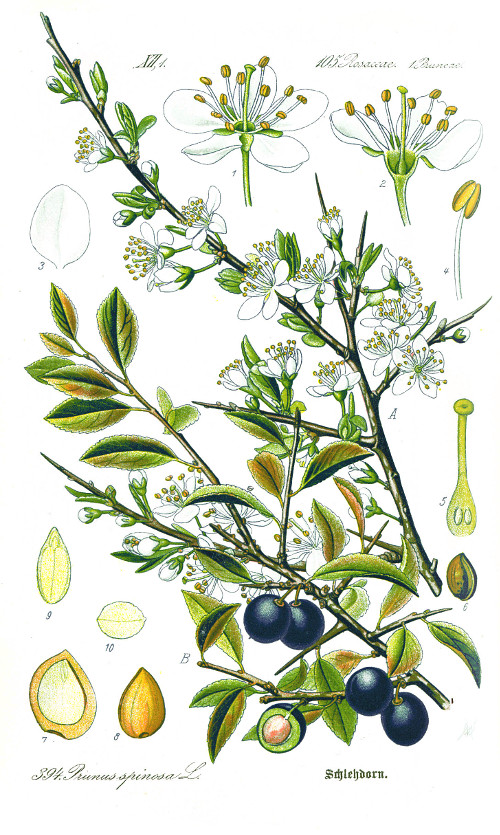Dies ist eine alte Version des Dokuments!
Prunus spinosa L. - Rosaceae - blackthorn, sloe, sloeberry, Schlehe, Schwarzdorn
Deciduous shrub, up to 3m high, native to Europe, West Asia, North Africa; branches reddish brown, spiny; leaves 2-5cm long, ovate to oblong, crenate, abaxially yellowish green and pubescent, adaxially dark green and sparsely appressed pubescent; flowers white, solitary, appearing before the leaves, petals 6mm long; fruits globose, deep blue to nearly black, glaucous.
„This species is cultivated for its edible fruit and as grafting stock for other species of Prunoideae.“
http://www.efloras.org/florataxon.aspx?flora_id=2&taxon_id=200011162
The ripe fruits are usually harvested after the first frost on the bush. By natural or artificial freezing, a big part of bitter and astringent tannins of the fruit is enzymatically degraded. In this case, the tannin content of the juice decreases from about 1% to less than 0.5%. Complete degradation of tannins is not intended because of their significant contribute to flavor.
http://de.wikipedia.org/wiki/Schlehdorn
Benzaldehyde, benzyl alcohol, 1-hexanol and (E)-2-hexenal were selected by AEDA as principal aroma-active components of P.spinosa.
[Dolezal, M., Velíšek, J., Famfulíková, P., Pfannhauser, W., Fenwick, G. R., & Khokhar, S. (2001). Chemical composition of less-known wild fruits. In Biologically-active phytochemicals in food: analysis, metabolism, bioavailability and function. Proceedings of the EUROFOODCHEM XI Meeting, Norwich, UK, 26-28 September 2001. (pp. 241-244). Royal Society of Chemistry.]
„In the 5-lipoxygenase test the fresh fruit juice of P.spinosa showed a good antioxidant activity when compared to trolox; in the DPPH test the samples showed IC50 values that were comparable to ascorbic acid, while the ORAC value was 36.02 μmol eq. trolox/g of fruit. These values are in accord with data reported in the literature for small fruits such as vaccinium, rubus and ribes. the antioxidant activity of red berries is correlated with the anthocyanin content. the results of this study indicate that the three most
representative anthocyanins in sloe fruit juice (cyanidin-3-rutinoside, peonidin-3-rutinoside and cyanidin-3-glucoside) contribute in varying amounts to the antioxidant properties.“
[Antioxidant activity of Prunus spinosa L. fruit juice., Fraternale, D., Giamperi, L., Bucchini, A., Ricci, D., Ital J Food Sci, Vol.21, 2009, 337-346]
http://www.chiriotti.it/pdf/ijfs/IJFS213.pdf#page=86

Thomé, O.W., Flora von Deutschland Österreich und der Schweiz, Tafeln, vol.3, t.394 (1885)
http://plantgenera.org/species.php?id_species=1266519
